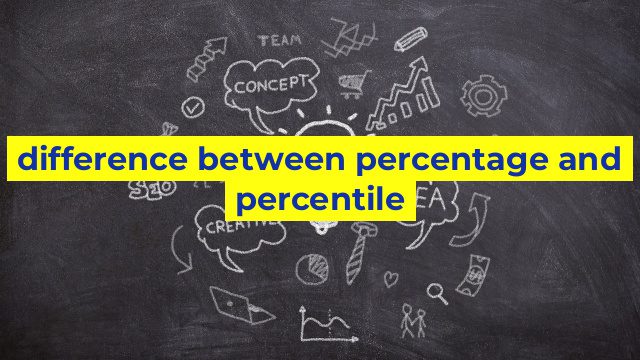The Difference Between Percentage and Percentile: Understanding the Basics
If you’re working with data or trying to analyze trends, you’ve likely come across the terms “percentage” and “percentile.” Although these two concepts sound similar, they have distinct meanings and serve different purposes when it comes to data analysis. In this article, we’ll explore the difference between percentage and percentile and help you understand when to use each of them.
What is a Percentage?
A percentage is a way of expressing a part of a whole as a fraction of 100. It’s represented by the symbol “%,” and it’s commonly used to indicate the relative size or proportion of something. For example, if 60 out of 100 students in a classroom scored an A on a test, we can say that the percentage of students who scored an A is 60%.
Percentage is used to compare the proportion of one group to another, which is useful when looking at data that consists of categorical variables. For instance, we might use percentages to compare the proportion of male and female employees in a company, or the percentage of people who prefer Coke to Pepsi.
What is a Percentile?
A percentile is a measure of relative position that indicates the value below which a certain percentage of data falls. It’s commonly used to identify where a particular data point ranks in relation to a larger set of data points. For example, if a student scored in the 90th percentile on a test, it means that their score is higher than 90% of the other students who took the test.
Percentiles are often used to identify outliers in a data set or to compare individual data points to the overall distribution of data. For instance, we might use percentiles to compare the income of an individual to the income distribution of the entire population, or to identify the students who scored highest on a standardized test.
The Key Differences Between Percentage and Percentile
While both percentage and percentile involve expressing a part of a whole as a portion of 100, there are several key differences between the two:
1. Purpose: A percentage is used to compare the proportion of one group to another, whereas a percentile is used to identify where a particular data point ranks in relation to a larger set of data points.
2. Calculation: A percentage is calculated by dividing a part by the whole and multiplying by 100, whereas a percentile is calculated by identifying the value below which a certain percentage of data falls.
3. Usage: Percentages are commonly used to analyze categorical data, while percentiles are often used to analyze continuous data.
Conclusion
In summary, percentages and percentiles are both important metrics in data analysis, but they serve distinct purposes. Percentages are used to compare the proportion of one group to another, while percentiles are used to identify where a particular data point ranks in relation to a larger set of data points. Understanding the difference between these two concepts is essential when working with data, as it can help you choose the right metric for the task at hand.
Table difference between percentage and percentile
| Percentage | Percentile | Definition | Example |
|---|---|---|---|
| Percentage | Percentile | Refers to a fraction of 100. It is a measure of the amount, rate, or proportion of something relative to the whole. | 70% of the students in a class scored above average. |
| Percentile | Percentage | Refers to a measure of the distribution of a dataset. It represents the percentage of observations that fall below a certain value in the distribution. | A student is in the 90th percentile on standardized tests, meaning they scored better than 90% of their peers. |


